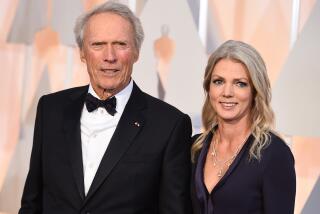Coloring for the Big Screen
“Do you mind if I draw while we talk?”
Rob Liefeld, 28, sits cross-legged on the carpeted floor of his spacious office at Extreme Studios, the Fullerton-based headquarters of his burgeoning comic-book empire.
Color paste-up proofs of comic-book drawings line the walls, and Badrock, a hulking, 8-foot, gray rubber behemoth, looms in the corner of the artist’s work space, which more resembles the romper-room of a hyperactive 13-year-old boy than it does the domain of a self-made multimillionaire.
Liefeld’s muscular fingers quickly push pencil lines across a blank sketch pad, and quickly the myriad impressions begin to resemble the belligerent, ever-grumpy Nick Fury, a popular Marvel Comics character.
“I see the picture in my head and it just makes it to the page,” Liefeld says casually. “I can do this all day. I just love doing this stuff.”
As a 10-year-old, Liefeld would spend hours drawing likenesses of “Star Wars” characters Luke Skywalker and Han Solo, making up his own story lines and adventures for them in quasi-comic-book form. Now, the popular creator of such titles as “X-Force” and “Youngblood” is in a position to see scenarios he’s created for his own unique brand of heroes end up on the silver screen.
In the last year alone, the rights to five of Liefeld’s characters have been bought by major Hollywood players.
“Prophet,” the story of a character who thwarts a doomsday military conspiracy, is in pre-production at TriStar Pictures, while New Line Cinema has purchased the rights to “Badrock,” in which a nerdy teenager drinks an experimental serum and becomes a huge, muscular creature made of stone, and “Avengelyne,” the story of a fallen angel seeking redemption on Earth. Liefeld created two properties specifically for powerful Hollywood figures to develop: “Dooms IV,” a complicated sci-fi thriller about four survivors of a destroyed space station, which Steven Spielberg has at Amblin/Universal, and “The Mark,” the story of an ancient talisman falling into the hands of an ordinary guy, who now suddenly holds the world’s balance of good and evil, which Tom Cruise has in development at Paramount for Cruise/Wagner.
Liefeld recalls that he was dissuaded from collecting comic books by his father, a Baptist minister, while his mother used to throw his secret stashes in the trash at their Anaheim home. His art teacher at Whittier Christian High School once advised his star pupil--who was apt to doodle during all of his math and English classes--that comic books were a waste of time and that he should concentrate on a career in commercial art.
Liefeld, however, has had the last laugh. After leaving Marvel in 1992 with fellow artists Jim Lee, Todd McFarlane and four others over issues of artistic control and profit-sharing, the consortium formed Image Comics Inc., a privately held group of seven independent publishing companies.
They shook up the industry by setting sales records and improving the quality of books--overtaking DC Comics (the home of stalwart titles “Batman” and “Superman”) as the nation’s third-largest comic-book company with annual sales of more than 40 million copies, generating $80 million.
Liefeld recently announced that he would pull Extreme Studios out of the Image group in January to focus on, among other things, his Hollywood television and movie projects.
“It’s just time to move on, and the split is amicable,” Liefeld says. “It just made sense to pull off in this direction, and I’m ready to form a bigger company.”
Liefeld’s father and sister now work for his company, his mother collects his work, his art teacher repeatedly invites him to come back to lecture, and Marvel has given him artistic control and sizable profit-sharing points over the company’s crown jewels, “Captain America” and the “Avengers.”
And Liefeld isn’t the only Image partner who is cashing in on the Hollywood comic-book craze.
McFarlane is filming the $40-million movie “Spawn,” based on his best-selling comic book. With visual effects by the same Industrial Light & Magic minds behind “Jurassic Park” and “The Mask,” the movie is about a murdered assassin resurrected as the general of hell’s army, struggling for redemption and the fiancee whose love brought him back from the grave.
“All comic-book artists secretly want a successful television or movie project because of the wider audience,” Liefeld says.
“Comics at their peak don’t have a tenth of that audience. The only way to make your characters into cultural icons is to have that kind of exposure. Even if it flops, when you’re sitting at the drawing table, you dream about seeing your work on the big screen, no matter what.”
Many artists and studios are excited about making movies out of comic books because of the millions of dollars worth of merchandising possibilities. Both McFarlane and Liefeld have a line of toys based on their comic-book characters through McFarlane Toys, a company owned by the “Spawn” creator.
*
Yet despite their popularity among fans, few comic-book properties outside of “Batman” and “Superman” have become hit movies. “The Mask” grossed more than $100 million domestically, but “Judge Dredd,” “Barb Wire,” “Tank Girl” and serial strips like “The Rocketeer,” “The Phantom” and “The Shadow” quickly disappeared.
“There are a lot of wrong reasons to do comic-book movies,” says comic-book industry expert Bill Liebowitz, who owns the Los Angeles-based chain Golden Apple comics.
“A lot of times they say, ‘This is a great comic,’ and it worked as a comic, but they fail to pay attention to the details of why it worked as one. The best reason to make a comic-book movie is good characters or stories with a strong visual impact. Nobody’s looking to make ‘Gone With the Wind’ out of ‘Badrock,’ but [New Line] feels that they can make good, translatable entertainment out of it.”
Brian Witten, New Line Cinema’s director of development and producer of Liefeld’s New Line productions as well as “The Prophet” with TriStar, feels that Liefeld’s tastes are in step with a large audience.
“The great thing about Rob is that he understands that a comic book is a piece of paper. With a movie you can’t translate it exactly because it will look goofy. ‘Avengelyne’ is the story of a fallen angel who tries to find redemption on Earth. She’s not going to wear the same skimpy outfits she wears in the comic book.”
“I just think the idea of a guy running around in a purple suit is a problem,” Liefeld says with a smirk. “Certain things work on paper held together with staples. Comics use bright colors to make things leap off the page, but movies are a different medium. The movie should reinforce the story line and the theme, but not necessarily the spandex.”
*
While the Image partners are known for their rivalries both as artists and entrepreneurs, Liefeld doesn’t feel intimidated that “Spawn,” due out next August, will reach movie theaters first. (None of Liefeld’s projects has advanced past the development stage.)
“I root for ‘Spawn’ and every other comic-book movie,” he says. “I hope all of them are successful, because any time one fails, it makes it that much harder to get one made. You’ll be in a meeting and say, ‘This character is nothing like “The Phantom,” ’ and they’ll say, ‘Well, “The Phantom” was a comic book--what’s the difference?’ ”
*
Meanwhile, back on Liefeld’s sketch pad, a now fully realized Nick Fury stares directly at his creator, and one can almost hear the cigar-chomping soldier’s gruff tones. Liefeld is including the character in an issue of “Captain America” that he’s working on.
“Can’t you see Harrison Ford playing him?” Liefeld says with jittery enthusiasm. He flips through some drawings, showing off the critically acclaimed artwork for his No. 1 issue of “Captain America.”
“I’m shooting Marvel a movie on paper. See the way the light hits Cap’s face here? That’s just like a movie. See his reflection here? Samuel L. Jackson could play this guy here--man, I’m dying to bring this to the big screen.”
Then Liefeld hesitates, remembering all the years he rode his bike from Anaheim to Fullerton to pick up his favorite books, and mowed lawns to earn money to buy back many of the valuable comics his mother discarded. He loves comics.
“If some of my things make it to the screen that’s cool, but holding the comic is the greatest thing to me,” he says. “I’m a fan of cinema, but that 32-page fix is still the best.”
More to Read
The biggest entertainment stories
Get our big stories about Hollywood, film, television, music, arts, culture and more right in your inbox as soon as they publish.
You may occasionally receive promotional content from the Los Angeles Times.






